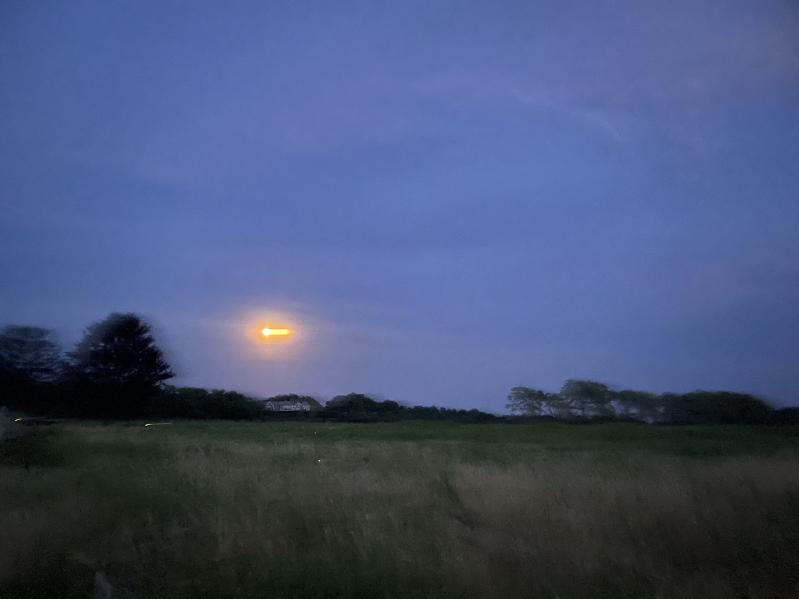Most articles about fireflies start with nostalgia and glow, but this one starts in a wet leaf pile.
Because this is tick territory, leaf piles have come to evoke fear; however, they are essential habitat for many insects including the beloved firefly, or lightning bug, which has suffered steep declines in recent years. Long before they emerge to mate during late spring and early summer evenings, they’re enjoying their youth, as it were, in these piles as larvae, dining on things like slugs, snails, and worms, according to the Xerces Society.
“They spend a lot of their time in leaf litter, which accumulates in natural ecosystems,” Jeffry Petracca, the entomology curator at the Long Island Aquarium, said by phone. However, much of the South Fork is no longer a natural ecosystem, it’s more an “egosystem,” and the way people manage their properties so they’re perfectly coiffed and prepped to serve human needs, is destroying habitat.
In fact, the three biggest threats to lightning bugs, listed on firefly.org — habitat loss, landscape lighting, and pesticide use — are like a “to do” list for most landscapers. Of course, insects in general will always face natural stressors. Our current drought, too, is bad for fireflies, which thrive in wet humid climates.
Mr. Petracca did a quick check of the iNaturalist app, which allows users to record and discuss nature observations, and said that in New York State there are about 15 species of fireflies that are commonly observed, but on Long Island, we now see only five. “It’s clear there is a loss,” he said.
“A 2019 report suggested that current rates of decline in insect species may lead to the extinction of 40 percent of insect species in the coming years,” he said. Of the confirmed 114 species of fireflies across the United States, 11 percent face extinction and 35 percent are showing concerning declines in population.
“The reality is that most people love animals. Insects are the most important animal group on earth. Without them, our ecosystems would be literally in chaos, which is what we’re beginning to live through right now,” Mr. Petracca said.
One way to support lightning bugs is to leave at least a portion of your property wild. The removal of leaf piles and every dead and rotting tree on a property does not occur without consequence to the insects and birds that use them as habitat.
Marilee Foster, a partner at Foster Farms in Sagaponack, has noticed a decline of fireflies in even the last three years. She blames “Broad spectrum tick spray and buildout of fallow fields,” for their decline. “It’s the tick spray that’s killing everything. As a farmer, I know what pesticides are capable of,” she texted this week.
Fireflies represent collateral damage in the great war on ticks and mosquitoes, waged yearly now across the East End. “Permethrin is dangerous for fireflies,” said Mr. Petracca. “It’s a generalist nerve toxin.” He said luring birds to your yard by planting native trees, shrubs and grasses is a better long-term solution. “Lure natural enemies of ticks and mosquitoes to your yard. They’re far better at picking them out than we ever could be.”
If mosquitoes bug you, he said, instead of spraying pesticide, be diligent about not letting water stand. Empty and refill bird baths every few days. The use of soil pesticides and chemical lawn fertilizer kill larvae, and should also be avoided.
Finally, if a firefly manages to survive, despite the loss of habitat and general use of pesticides, the trend to light up trees, shrubs, house facades, even mailboxes makes it difficult for the adults to mate. For fireflies the light pollution is disorienting, and downright deadly.
“If lights are on at night, they may not be able to see some members of their species and miss out on a mating opportunity,” said Mr. Petracca.
According to the Farmers’ Almanac, mating fireflies can be identified by their “flash patterns.”
For example, Photinus pyralis is our most common variety and makes a J-shape flash. Other species on Long Island are identified by the frequency of their flashes. Photinus consimilis makes a double flash every five seconds; photinus collustrans flashes three times, in two to three seconds.
“People don’t really think about how their lighting affects the environment, but once they do, they’re capable of doing something about it,” said Susan Harder, founder of the Dark Sky Society. “There’s a lot of hard things in life, but this is a no-brainer. It’s ridiculous to leave lights on all night, or worse, when people are back in the city.”
“There’s always hope for a negative situation,” said Mr. Petracca. “Nature is going to solve it one way or the other. Some fireflies will adapt more than others. Even if we lose most of the biodiversity, a dominant species will emerge. Humans are also animals, and one of the most influential. We can easily destroy ecosystems without trying, but we can also protect them.”




